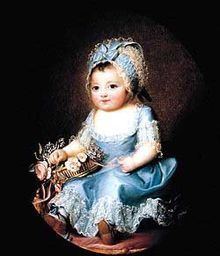 | ||
Born 5 August 1776
Palace of Versailles, France ( 1776-08-05 ) Father Charles Philippe de France Mother Princess Maria Theresa of Savoy Died 5 December 1783, Palace of Versailles, Versailles, Yvelines, France Parents Charles X of France, Princess Maria Theresa of Savoy Grandparents Louis, Dauphin of France Uncles Louis XVI of France, Louis XVIII of France Cousins Marie Thérèse of France, Louis Joseph - Dauphin, Louis XVII of France, Princess Sophie Hélène B Similar Charles X of France, Princess Maria Theresa, Louis XVI of France, Marie Thérèse of France, Louis - Dauphin of France | ||
Sophie d'Artois (5 August 1776 – 5 December 1783) was a French princess of the House of Bourbon.
Contents
Biography
Sophie d'Artois was born at the Palace of Versailles during the reign of her paternal uncle, Louis XVI. Her father was Charles Philippe de France, known as the comte d'Artois. Her mother was Princess Maria Theresa of Savoy, third daughter of Victor Amadeus III of Sardinia and Maria Antonietta of Spain.
She was known as Mademoiselle – a very prestigious style of address which was given to the most senior unmarried princess at the court of Versailles. Sophie was also titled Mademoiselle d’Angoulême and Mademoiselle d'Artois – the former reflecting the Duke of Angoulême which was the title of her brother Louis Antoine d'Artois. Artois was derived from her father's Appanage of the County of Artois.
Her father, as a son of the Dauphin of France, held the rank of Grandson of France. Louis XVI declared that his niece and her siblings would be regarded as Grandchildren of France despite not being born to a King or Dauphin of France. This rank of Grandchild, which immediately followed the Children of France allowed Sophie to the style of Royal Highness but she was always known as Mademoiselle.
Sophie died at the Palace of Versailles at the age of seven. She was buried at the Royal Basilica of Saint Denis outside Paris, the traditional burial place of Bourbon royalty. Portraits of Sophie and her family exist at Versailles, one of them being by the famous Élisabeth-Louise Vigée-Le Brun.
